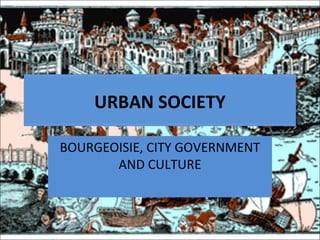Report
Share

Recommended
More Related Content
What's hot
What's hot (20)
Burdur governorate provinncial directorate of culture and tourism

Burdur governorate provinncial directorate of culture and tourism
La ciudad medieval / Medieval towns / Late Middle Ages

La ciudad medieval / Medieval towns / Late Middle Ages
Similar to Urban society
Similar to Urban society (20)
Hum1020 the calm before the storm feudalism, the manor, & medieval cities

Hum1020 the calm before the storm feudalism, the manor, & medieval cities
2c.3 social structure; men, women, freedmen, slaves

2c.3 social structure; men, women, freedmen, slaves
More from cayetana vega
More from cayetana vega (20)
Urban society
- 1. URBAN SOCIETY BOURGEOISIE, CITY GOVERNMENT AND CULTURE
- 2. THE APPEARANCE OF THE BOURGEOISIE • The growth of cities transformed feudal society. • Kings, nobles and clergy conceded more personal freedom and rights to their subjects • As a result, a new social class was formed: the bourgeoisie.
- 3. • The bourgeoisie worked as artisans or traders • They were not dependent on a feudal lord
- 4. There were differences among the bourgeoisie: HIGH BOURGEOISIE: PETTY BOURGEOISIE: • Were important traders • Were master artisans and bankers and small scale traders
- 5. The rich bourgeoisie of Venice built luxurious mansions to live in. CA D’ORO IN VENICE
- 6. Other social groups living in cities: Nobles, Clergy and Peasants Minorities such as Jews Jews worked as doctors, moneylenders or artisans and lived in a separate neighborhood called the Jewish quarter
- 7. CITY GOVERMENT • Cities were governed by magistrates, who worked under the mayor in the areas of finance, order and justice. • Over time, this resulted in cities being governed by the richest families, who made up a privileged group called urban patricians
- 8. CULTURE • During the 12th century, the bourgeoisie and the nobles began to develop an appreciation for knowledge. • This appreciation, together with economic and urban growth, led to the development of schools, and later universities
- 10. SALAMANCA UNIVERSITY LIBRARY Library University of Salamanca